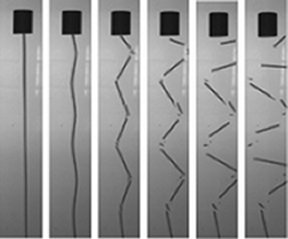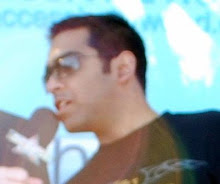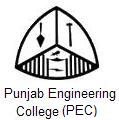Sphagetti and Brittle Behavior of Materials
 (High-speed video reveals that (left to right) a stick of dry spaghetti whacked at the end by a metal slug (top) buckles in waves before shattering. Studies done by Dr.Belmonte)
(High-speed video reveals that (left to right) a stick of dry spaghetti whacked at the end by a metal slug (top) buckles in waves before shattering. Studies done by Dr.Belmonte)Ever wonder how scientists think of silly thing in order to understand some complex engineering behavior? Thats what you will read in this article from Science News Online: .
That's the Way the Spaghetti Crumbles
- Peter Weiss
"Great scientists sometimes do silly experiments. The renowned physicist and Nobel prize winner Richard P. Feynman, for instance, once got it into his head to figure out why uncooked spaghetti doesn't snap neatly in two when you bend it far enough to break. Pay attention next time, and you'll notice that the pasta tends to shatter into three or more fragments of unequal lengths.
In the midst of making a spaghetti dinner for themselves one night about 20 years ago, Feynman and a friend—supercomputing innovator W. Daniel Hillis—launched into a brief investigation of this perplexing breaking-pasta performance. "We ended up, at the end of a couple of hours, with broken spaghetti all over the kitchen and no real good theory about why spaghetti breaks in three," Hillis recalls, as quoted in the book No Ordinary Genius by Christopher Sykes (1994, W.W. Norton)."
Click here for complete article and read it completely with a surprise mixed smile.
That's the Way the Spaghetti Crumbles
- Peter Weiss
"Great scientists sometimes do silly experiments. The renowned physicist and Nobel prize winner Richard P. Feynman, for instance, once got it into his head to figure out why uncooked spaghetti doesn't snap neatly in two when you bend it far enough to break. Pay attention next time, and you'll notice that the pasta tends to shatter into three or more fragments of unequal lengths.
In the midst of making a spaghetti dinner for themselves one night about 20 years ago, Feynman and a friend—supercomputing innovator W. Daniel Hillis—launched into a brief investigation of this perplexing breaking-pasta performance. "We ended up, at the end of a couple of hours, with broken spaghetti all over the kitchen and no real good theory about why spaghetti breaks in three," Hillis recalls, as quoted in the book No Ordinary Genius by Christopher Sykes (1994, W.W. Norton)."
Click here for complete article and read it completely with a surprise mixed smile.
My Opinion: Can we apply the mechanical behavior of uncooked spaghetti equally ideally to metallic materials also, knowing that atomic bonding is different in both these class of materials ?



